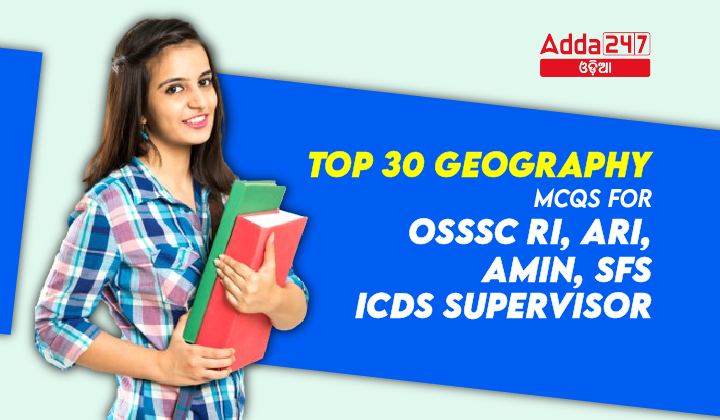Geography is a crucial subject for various competitive exams in India, including those conducted by the Odisha Subordinate Staff Selection Commission (OSSSC) for the positions of Revenue Inspector (RI), Assistant Revenue Inspector (ARI), Amin, Senior Field Surveyor (SFS), and ICDS Supervisor. To aid aspirants in their preparation, here are the top 30 multiple-choice questions (MCQs) covering various aspects of Indian Geography:
Top 30 Geography MCQs For OSSSC RI,ARI, Amin, SFS, ICDS Supervisor
- Who was the first person to use the word “geography”?
a. Eratosthenes
b. Strabo
c. Ptolemy
d. William Morris Davis
ANSWER: a. Eratosthenes - The Earth is comprised of how many continental and oceanic tectonic plates?
a. 10
b. 13
c. 20
d. 14
ANSWER: d. 14 - Mantle layer is situated between _____________
a. Crust and Lithosphere
b. Crust and Core
c. Core and Lithosphere
d. Inner Core and Outer Core
ANSWER: b. Crust and Core - Mantle is composed of _____________
a. Silicon and Magnesium
b. Silicon
c. Magnesium
d. None of the above
ANSWER: a. Silicon and Magnesium - After oxygen, which is the most abundant element in the earth’s crust?
a. Sodium
b. Silicon
c. Magnesium
d. Aluminium
ANSWER: b. Silicon - Which one of the following is the cause for a change in the season?
a. Earth’s Rotation and Revolution
b. Earth’s Rotation
c. Earth’s Revolution
d. None of the above
ANSWER: c. Earth’s Revolution - In which direction does the earth spin on its axis?
a. West to East
b. East to West
c. South to North
d. North to South
ANSWER: a. West to East - How long does Earth take to complete one rotation?
a. 23 Hours, 56 minutes
b. 23 Hours, 55 minutes
c. 23 Hours, 54 minutes
d. 22 Hours, 60 minutes
ANSWER: a. 23 Hours, 56 minutes - Which is the longest and shortest day in the northern hemisphere?
a. 21 June, 21 December
b. 20 June, 21 December
c. 21 June, 20 December
d. 20 June, 20 December
ANSWER: a. 21 June, 21 December - ______________ is the longest and shortest day in the southern hemisphere.
a. 21 December, 20 June
b. 20 December, 20 June
c. 22 December, 21 June
d. 22 December, 20 June
ANSWER: c. 22 December, 21 June - The spring tides occur when _______________________________
a. The Earth and the Moon are in a line
b. The Earth, the Sun and the Moon are in a line
c. The Moon and the Sun are in a line
d. None of the above
ANSWER: b. The Earth, the Sun and the Moon are in a line - What is the time difference between the Greenwich time and Indian Standard time?
a. 5
b. 5 and ½
c. 5 and ¼
d. 4 and ½
ANSWER: b. 5 and ½ - What is the number of latitudes and longitudes?
a. 180 latitudes, 360 meridians of longitudes
b. 180 latitudes, 180 meridians of longitudes
c. 90 latitudes, 180 meridians of longitudes
d. 360 latitudes, 180 meridians of longitudes
ANSWER: a. 180 latitudes, 360 meridians of longitudes - _____________ is the oldest mountain?
a. Aravallis
b. Himalayas
c. Andes
d. Alps
ANSWER: a. Aravallis - Which line demarcates the boundary of India and Pakistan?
a. Radcliffe Line
b. 24th Parallel
c. 38th Parallel
d. Mc Mohan Line
ANSWER: a. Radcliffe Line - In terms of area, India is at which position in the world?
(a) 7th largest
(b) 4th largest
(c) 5th largest
(d) 6th largest
Correct Answer: (a) 7th largest
Explanation: In terms of size, India is the seventh largest country in the world. The largest country in the world is Russia. The seven largest countries by area are:
Russia
Canada
China
United States
Brazil
Australia
India - India and Sri Lanka are separated by which among the following strait?
(a) Malacca Strait
(b) Sunda Strait
(c) Palk Strait
(d) Strait of Gibraltar
Correct Answer: (c) Palk Strait
Explanation: India and Sri Lanka are narrowly separated by the Palk Strait. - The Indian mainland extends between the following latitudes?
(a) 8°4’N to 37°6′ N latitudes
(b) 9°4’N to 38°6′ N latitudes
(c) 3°4’N to 32°6′ N latitudes
(d) 5°4’N to 37°6′ N latitudes
Correct Answer: (a) 8°4’N to 37°6′ N latitudes
Explanation: India lies completely in the Northern Hemisphere. The Indian mainland extends between 8°4’N to 37°6′ N latitudes and from 68°7′ E to 97°25′ E longitudes. India’s latitudinal and longitudinal extent is about 29 degrees. - The length of India from north to south is which among the following?
(a) 3,214 km
(b) 3,414 km
(c) 4,214 km
(d) 2,933 km
Correct Answer: (a) 3,214 km
Explanation: India measures about 3,214 km from north to south and 2,933 km from east to west. - The easternmost point of India is located in the state of?
(a) Assam
(b) Arunachal Pradesh
(c) Meghalaya
(d) Sikkim
Correct Answer: (b) Arunachal Pradesh
Explanation: Kibithu is the easternmost place of India. It is located in the Anjaw district of Arunachal Pradesh. The Lohit River enters India at Kibithu. - The westernmost point of India is located in the state of?
(a) Maharashtra
(b) Gujarat
(c) Rajasthan
(d) Punjab
Correct Answer: (b) Gujarat
Explanation: Guhar Moti is the westernmost place of India. It is located in the Kutch district of Gujarat. - The standard time meridian of India is?
(a) 83°30′ E
(b) 82°30′ E
(c) 81°30′ E
(d) 80°30′ E
Correct Answer: (b) 82°30′ E
Explanation: The standard time meridian of India is 82°30′ E. It passes through the following states of India: Uttar Pradesh, Odisha, Andhra Pradesh, Madhya Pradesh, and Chhattisgarh. - Broadly by how many hours does the local time of the easternmost point of India differ from that of the westernmost point?
(a) 1 hour
(b) 2 hours
(c) 3 hours
(d) 4 hours
Correct Answer: (b) 2 hours
Explanation: The variation in local time between the eastern and western extremities of India is about two hours. - India accounts for the following percent of the world’s total land area?
(a) 3.42 percent
(b) 4.42 percent
(c) 5.42 percent
(d) 2.42 percent
Correct Answer: (d) 2.42 percent
Explanation: In terms of size, India is the seventh largest country in the world. Its total area is 3.28 million sq. km. It accounts for 2.42 percent of the world’s total land area. - Which one of the following countries shares the longest land border with India?
(a) Bangladesh
(b) China
(c) Pakistan
(d) Myanmar
Correct Answer: (a) Bangladesh
Explanation: Bangladesh shares the longest land border with India, spanning approximately 4,096 kilometers. - Type of climate in India is ?
(a) Temperate
(b) Continental
(c) Tropical Evergreen
(d) Tropical Monsoon
Correct Answer: (d) Tropical Monsoon
Explanation:
Climate is the average weather conditions in a place over a long period of time.
India has a tropical monsoon type of climate.
This type of climate is experienced in the tropical area roughly between 20° N and 20° S.
The word ‘monsoon’ is derived from the Arabic word ‘Mausim’ which means ‘Season’. - Major rainfall occurs in India due to ?
(a) Southwest monsoon winds
(b) Northwest monsoon winds
(c) Northeast monsoon winds
(d) None of the above
Correct Answer: (a) Southwest monsoon winds
Explanation:
Southwest monsoon winds cause widespread rain over most parts of India.
Since these winds are sea bearing and blow over warm water bodies before reaching land, they are moisture laden and cause plentiful rainfall in India. - The cause of western disturbances is ?
(a) Westerly Jet stream
(b) Easterly Jet stream
(c) Both of the above
(d) None of the above
Correct Answer: (a) Westerly Jet stream
Explanation:
Jet streams are a narrow belt of high altitude (above 12,000 m) winds in the troposphere. Their speed varies from about 110 km/h in summer to about 184 km/h in winter.
Jet streams in the upper air system influence the climate of India.
The Westerly Jet stream is responsible for bringing western disturbances from the Mediterranean region into the Indian subcontinent. It causes winter rain in the northwestern plains of India.
This rain is considered to be very beneficial for the wheat crops of northern plains.
These depressions are generally followed by cold waves which bring down temperatures considerably. - The El – Nino Effect causes ?
(a) Lower rainfall in India
(b) Higher rainfall in India
(c) Cyclones in India
(d) Has no impact
Correct Answer: (a) Lower rainfall in India
Explanation:
Weather conditions in India are influenced by the El-Nino effect.
Irregular warming of tropical Pacific waters is known as the El-Nino effect.
It affects the global pattern of pressure and wind systems including the southwest monsoon winds in the Indian Ocean.
Due to the El-Nino effect, India receives lesser than expected rainfall and sometimes drought-like situations. - When India has winter, the sun vertically shines over ?
(a) Tropic of Capricorn
(b) Tropic of Cancer
(c) Equator
(d) None of the above
Correct Answer: (a) Tropic of Capricorn
Explanation:
During winter in India, which occurs from December to February, the sun shines vertically over the Tropic of Capricorn, located at 23.5° south latitude.









